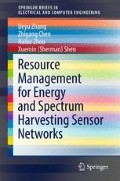Abstract
In this chapter, we investigate the spectrum sensing and access of a heterogeneous spectrum harvesting sensor network (HSHSN) which consists of EH-enabled spectrum sensors and battery-powered data sensors. The former detects the availability of licensed channels, while the latter transmits sensed data to the sink over the available channels. Two algorithms that operate in tandem are proposed to achieve the sustainability of spectrum sensors and conserve energy of data sensors, while the EH dynamics and PU protections are considered. Extensive simulation results are given to validate the effectiveness of the proposed algorithms.
Access this chapter
Tax calculation will be finalised at checkout
Purchases are for personal use only
Notes
- 1.
The Frobenius norm is defined as the square root of the sum of the absolute squares of the elements of the matrix. For example, if
$$\begin{aligned} \varvec{A} = \begin{bmatrix} a_{11}&a_{12} \\ a_{21}&a_{22} \end{bmatrix}, \end{aligned}$$then
$$\begin{aligned} || \varvec{A} ||_{Fr} = \sqrt{|a_{11}|^2 + |a_{12}|^2 + |a_{21}|^2 + |a_{22}|^2}. \end{aligned}$$ - 2.
In [12], the real experimental data obtained from the baseline measurement system (BMS) of the Solar Radiation Research Laboratory (SRRL) shows that the EH rate ranges from 0 to 100 mW for most of the day.
References
D. Zhang, Z. Chen, J. Ren, Z. Ning, K.M. Awad, H. Zhou, X. Shen, Energy harvesting-aided spectrum sensing and data transmission in heterogeneous cognitive radio sensor network. IEEE Trans. Veh. Technol. (to be published). doi:10.1109/TVT.2016.2551721
P. Pratibha, K.H. Li, K.C. Teh, Dynamic cooperative sensing-access policy for energy-harvesting cognitive radio systems. IEEE Trans. Veh. Technol. (to be published). doi:10.1109/TVT.2016.2532900
W. Zhang, Y. Guo, H. Liu, Y. Chen, Z. Wang, J. Mitola, Distributed consensus-based weight design for cooperative spectrum sensing. IEEE Trans. Parallel Distrib. Syst. 26(1), 54–64 (2015)
S.K. Nobar, K.A. Mehr, J.M. Niya, RF-powered green cognitive radio networks: architecture and performance analysis. IEEE Commun. Lett. 20(2), 296–299 (2016)
N.I. Miridakis, T.A. Tsiftsis, G.C. Alexandropoulos, M. Debbah, Green cognitive relaying: Opportunistically switching between data transmission and energy harvesting. IEEE J. Sel. Areas Commun. (to be published)
S.-S. Byun, I. Balasingham, X. Liang, Dynamic spectrum allocation in wireless cognitive sensor networks: improving fairness and energy efficiency, in Proceedings of IEEE VTC, 2008, pp. 1–5
Z. Hu, Y. Sun, Y. Ji, A dynamic spectrum access strategy based on real-time usability in cognitive radio sensor networks, in Proceedings of IEEE MSN, 2011, pp. 318–322
J. Ayala Solares, Z. Rezki, M. Alouini, Optimal power allocation of a single transmitter-multiple receivers channel in a cognitive sensor network, in Proceedings of IEEE ICWCUCA, 2012, pp. 1–6
M. Naeem, K. Illanko, A. Karmokar, A. Anpalagan, M. Jaseemuddin, Energy-efficient cognitive radio sensor networks: Parametric and convex transformations. Sensors 13(8), 11 032–11 050 (2013)
N. Zhang, H. Liang, N. Cheng, Y. Tang, J. Mark, X. Shen, Dynamic spectrum access in multi-channel cognitive radio networks. IEEE J. Sel. Areas Commun. 32(11), 2053–2064 (2014)
R. Deng, J. Chen, C. Yuen, P. Cheng, Y. Sun, Energy-efficient cooperative spectrum sensing by optimal scheduling in sensor-aided cognitive radio networks. IEEE Trans. Veh. Technol. 61(2), 716–725 (2012)
Y. Zhang, S. He, J. Chen, Y. Sun, X. Shen, Distributed sampling rate control for rechargeable sensor nodes with limited battery capacity. IEEE Trans. Wirel. Commun. 12(6), 3096–3106 (2013)
P. Tehrani, L. Tong, Q. Zhao, Asymptotically efficient multichannel estimation for opportunistic spectrum access. IEEE Trans. Signal Process. 60(10), 5347–5360 (2012)
H. Kim, K. Shin, Efficient discovery of spectrum opportunities with mac-layer sensing in cognitive radio networks. IEEE Trans. Mobile Comput. 7(5), 533–545 (2008)
Y.-C. Liang, Y. Zeng, E. Peh, A.T. Hoang, Sensing-throughput tradeoff for cognitive radio networks. IEEE Trans. Wirel. Commun. 7(4), 1326–1337 (2008)
S. Atapattu, C. Tellambura, H. Jiang, Energy Detection for Spectrum Sensing in Cognitive Radio. Springer Briefs in Computer Science (Springer, 2014)
R. Rubinstein, The cross-entropy method for combinatorial and continuous optimization. Methodol. Comput. Appl. Probab. 1(2), 127–190 (1999)
A. Costa, O.D. Jones, D. Kroese, Convergence properties of the cross-entropy method for discrete optimization. Oper. Res. Lett. 35(5), 573–580 (2007)
C. Floudas, V. Visweswaran, Comput. Chem. Eng. 14(12), 1397–1417 (1990)
J. Gorski, F. Pfeuffer, K. Klamroth, Biconvex sets and optimization with biconvex functions: a survey and extensions. Math. Methods Oper. Res. 66(3), 373–407 (2007)
G.B. Dantzig, M.N. Thapa, Linear Programming 2: Theory and Extensions, vol. 2 (2003)
S. Boyd, L. Vandenberghe, Convex Optimization (Cambridge University Press, 2004)
Y. Pei, Y.-C. Liang, K. Teh, K.H. Li, Energy-efficient design of sequential channel sensing in cognitive radio networks: optimal sensing strategy, power allocation, and sensing order. IEEE J. Sel. Areas Commun. 29(8), 1648–1659 (2011)
T. Shu, M. Krunz, S. Vrudhula, Joint optimization of transmit power-time and bit energy efficiency in CDMA wireless sensor networks. IEEE Trans. Wirel. Commun. 5(11), 3109–3118 (2006)
H. Yu, W. Tang, S. Li, Optimization of cooperative spectrum sensing in multiple-channel cognitive radio networks, in Proceedings of IEEE GLOBECOM, 2011, pp. 1–5
Author information
Authors and Affiliations
Corresponding author
Rights and permissions
Copyright information
© 2017 The Author(s)
About this chapter
Cite this chapter
Zhang, D., Chen, Z., Zhou, H., Shen, X. (2017). Spectrum Sensing and Access in Heterogeneous SHSNs. In: Resource Management for Energy and Spectrum Harvesting Sensor Networks. SpringerBriefs in Electrical and Computer Engineering. Springer, Cham. https://doi.org/10.1007/978-3-319-53771-9_3
Download citation
DOI: https://doi.org/10.1007/978-3-319-53771-9_3
Published:
Publisher Name: Springer, Cham
Print ISBN: 978-3-319-53770-2
Online ISBN: 978-3-319-53771-9
eBook Packages: EngineeringEngineering (R0)

